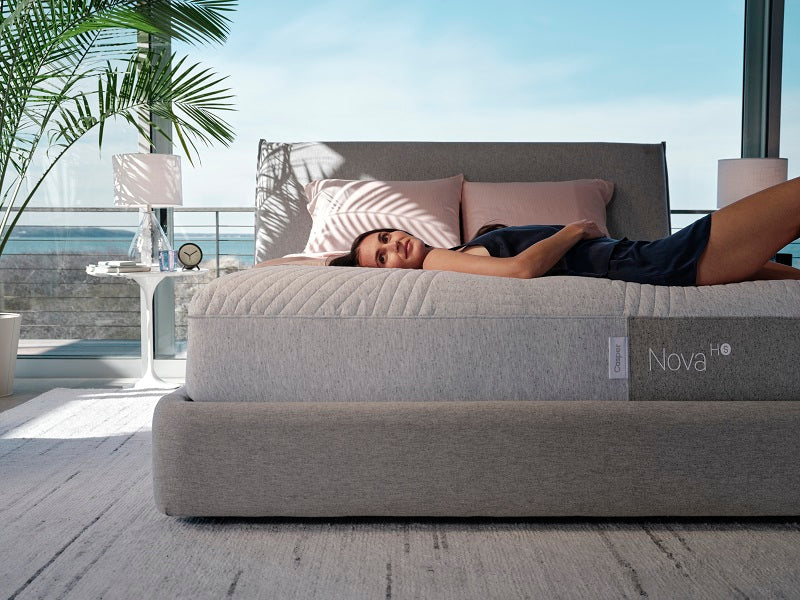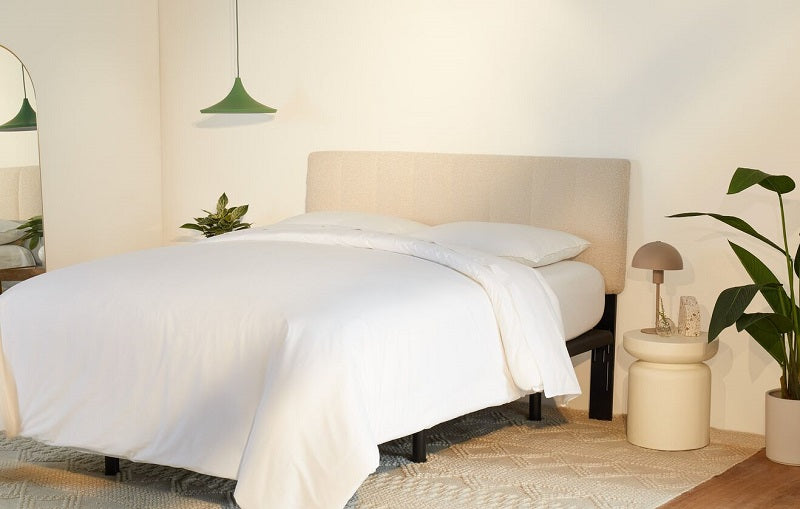Upholstered bed frames can complete your bedding to give it a cozy-meets-sophisticated look. When you consider their wide-ranging versatility, plush comfort, and an array of customizable aesthetics, it’s easy to understand why so many people spring for them.1
One chief way you can keep your upholstered bedframe looking pillowy and inviting is by keeping it clean with a vacuum, lint roller, and the occasional gentle fabric cleaner.
Whether you just purchased your first upholstered bedframe or you’re a long-time owner embarking on a bedroom deep-clean, we’ve got you covered. Keep reading for the rundown on how to clean upholstered bed frame styles, which cleaners to use, how often to clean them, and some tips on maintaining a spic and span frame between cleanings.
Before You Begin, Know Your Fabric
If there’s one place to begin understanding how to clean fabric bed frame designs, it’s with the fabric itself. Although some cleaning tips are universally applicable, others are specific to certain textiles and detrimental to others.
When you know the fabric of your upholstered frame and the proper way to clean and care for it, you can ensure you don’t stain or damage the upholstery fabric on your frame while cleaning it.
The list of fabrics that are commonly used to upholster bed frames includes everything from natural fabrics and premium textiles to synthetic and blended options. Common upholstery materials and their cleaning quirks include2:
- Chenille - Soft but prone to snagging. Vacuum gently and blot stains with mild soap and water. Avoid scrubbing or oversaturating.
- Cotton - Durable and easy to clean. Vacuum regularly; spot-clean with mild detergent and warm water.
- Leather - Easy to wipe clean, but condition it to prevent cracking.
- Leatherette or vinyl - Water-resistant and low-maintenance. Wipe with a damp cloth and mild soap; avoid harsh cleaners to prevent cracking.
- Linen - Spot-clean with mild detergent and air dry.
- Suede - No water! Use a dry brush or suede eraser.
- Velvet - Luxurious but high-maintenance. Use a soft brush and light steaming.
- Polyester – Resilient and stain-resistant; most water-based cleaners work.
If you aren’t sure what type of upholstery fabric you’re dealing with, check the care instructions on the product tag —it’s your cheat sheet for proper cleaning. Not all fabrics are created equal, and using the wrong cleaner can turn a small stain into a big problem. Look for cleaning codes that indicate the safest method:
- “W” = Water-based cleaners are safe
- “S” = Use solvent-based cleaners only (no water!)
- “W/S” = Either type of cleaner works
- “X” = Vacuum only—no liquid cleaners allowed!
Perform Light Cleans Weekly
Upholstered bed frames are susceptible to a few common contaminants. Some, like oil from your hair and body, are deposited regularly but build up more slowly. Other bedroom debris becomes apparent more quickly, like:
- Dust
- Dirt
- Hair
As anyone who lives with a furry friend can attest, pet hair tends to accumulate at a breakneck pace and can show up pretty quickly.
Fortunately, all it takes to tamp it down is a vacuum cleaner, an upholstery attachment, and a few minutes every week.3 If you don’t have an upholstery attachment on your vacuum, you can opt for a lint roller.
Spot-Clean Stains Immediately
When your cozy bed is as decadent and comfy as the best-upholstered models, it makes sense that you’d want to spend as much time in it as possible. And because so many styles feature padded headboards covered in soft fabrics, they’re perfect for binge-watching and your favorite snacks or a Sunday morning breakfast in bed.
Invariably, those are just the sort of activities that can lead to spots, stains, and other fabric defects. When accidents occur, spot-cleaning is necessary to banish stains before they settle into the upholstery for the long haul.
To treat one-off spots on your upholstered bedframe, grab a clean sponge and apply warm water and some dish soap or another fabric-safe cleaning solution. Then, simply (and gently) blot at the stain until it is fully removed.
And Deep-Clean Monthly
Spot-cleaning stains the second they happen, and vacuuming up dust, dirt, and hair once a week are important steps toward maintaining your upholstered bed frame. But they perform one other crucial function as well: they make periodic deep cleaning less laborious and more effective.
That said, it’s still helpful to deep-clean your bedframe about once a month. Depending on the fabric, your lifestyle, and your bedroom environment, you may opt to do this more often.
The procedure for how to clean fabric bed frame upholstery deeply is as follows:
- Mix your cleaning solution – For fabrics that are labeled with a “W” or a “W/S,” you can use a water-based cleaning solution. In most cases, a mild dish detergent should do the trick, but you can also use baking soda, fabric cleaner, or upholstery shampoo.3
- Strip bedding – You’ll have a much easier time cleaning the bed frame if you don’t have sheets, comforters, or other bedding getting in the way, so go ahead and strip the duvet or bedding from the mattress before you get started.
- Scrub the frame – Dampen a sponge or dry cloth in the cleaning solution and then use it to gently scrub the fabric. You needn’t scrub too hard—when it comes to how to clean fabric bed frame upholstery, a little elbow grease goes a long way.
- Wipe away excess soap and water – Use a fresh sponge or dry cloth to soak up any excess soap and water, then leave the frame out to air dry in an open space (or outdoors if the frame can be shielded from outdoor elements).
When to Call a Professional
Sometimes, DIY just doesn’t cut it. If your upholstered bed has:
- Deep-set stains that won’t budge
- Musty odors that won’t go away
- Visible mold or mildew
- Expensive or delicate fabric you don’t want to risk ruining
…it’s worth calling in a professional upholstery cleaner. They have high-powered tools and fabric-safe solvents to refresh your bed frame without damage.
FAQs
How often should I clean my upholstered bed frame?
Weekly light cleaning, spot-cleaning stains ASAP, and deep cleaning once a month keep your bed looking great.
Can I use a carpet cleaner on my bed frame?
Not always. Carpet cleaners may be too harsh for delicate fabrics. Stick to upholstery-safe cleaners.
Can I steam clean my bed frame?
If the fabric allows, yes! Steam cleaning is great for removing odors and bacteria.
How do I get rid of dust on my fabric headboard?
Vacuum weekly, use a lint roller, and sprinkle baking soda occasionally to absorb oils and odors.
For Comfy and Aesthetic Upholstered Frames, Choose Casper
If you’re in the market for a high-quality bed that looks at you with come-hither eyes every night, look no further than the upholstered bed frames from Casper, like the Haven and the original Upholstered Bed Frame. Soft, streamlined, and made using premium textiles, our upholstered bed frames are available in Full, Queen, and King sizes, at prices you won’t need to sleep on.
Sources:
- The Inside.Why Are Upholstered Beds So Popular?https://www.theinside.com/blog/why-are-upholstered-beds-so-popular/
- Silver Bobbin.Best Fabric for Headboard Covering.https://silverbobbin.com/best-fabric-for-headboard-covering/
- Home Furniture DIY.How to Clean Upholstered Bed Frame? 17 Easy Methods.https://homefurniturediy.com/how-to-clean-upholstered-bed-frame/











